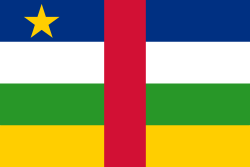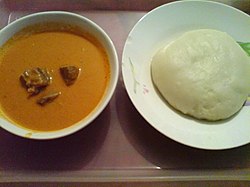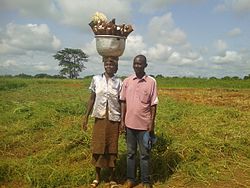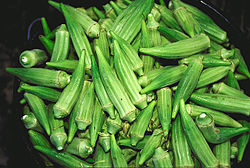- A manioc (cassava) tuber
- Groundnuts (peanuts) and rice harvested in the Central African Republic
- Okra is commonly eaten in the Central African Republic. [3]
- A Boston lettuce plantation in northern Central African Republic
| Part of a series on the |
| Culture of the Central African Republic |
|---|
 |
| People |
| Languages |
| Cuisine |
| Religion |
| Music |
| Sport |


Central African cuisine includes the cuisines, cooking traditions, practices, ingredients and foods of the Central African Republic (CAR). Indigenous agriculture in the country includes millet, sorghum, banana, yam, [1] okra, yellow onion, garlic, spinach, rice and palm oil. Imported crops of American origin include maize, manioc (cassava), peanuts, chili peppers, [1] sweet potato and tomato. [2] Additional foods include onions, garlic, chiles and peanuts. [3]
Contents
- Common foods and dishes
- Beverages
- Non-alcoholic beverages
- Alcoholic beverages
- Cuisine in Bangui
- Food scarcity
- History
- See also
- References
Meat can be scarce in the Central African Republic, although fish is used in a variety of dishes, and other sources of protein include peanuts and insects such as cicadas, grasshoppers, crickets and termites. [3] Common meats in Central African cuisine include chicken and goat. [2] Wild game is also hunted, especially in rural areas and during the grass-burning dry season. [4] Staple foods include starches, such as millet, rice, sesame and sorghum. A variety of vegetables and sauces are also consumed. [1] [3]
Roadside stalls sell foods such as baked goods and makara (a type of fried bread), sandwiches, barbecued meat and snacks. [4] In the forests and in markets of Bangui where forest items are sold, caterpillars and the koko leaf are eaten. [4] Restaurants are mostly for expatriates. [4] Wild tubers, leaves, and mushrooms are used. [4] Palm oil is widely used in various dishes. [4]
The capital city of Bangui has western foods and hotel restaurants. [5] The legal drinking age is 18. Muslims are prohibited from drinking alcohol. [5] The PK5 area is known for its smaller restaurants serving reasonably priced traditional dishes. [5]









